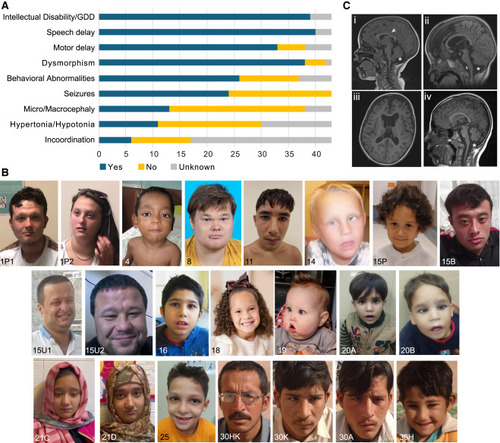Fig. 2
- ID
- ZDB-FIG-250526-41
- Publication
- Efthymiou et al., 2025 - Biallelic pathogenic variants in TRMT1 disrupt tRNA modification and induce a neurodevelopmental disorder
- Other Figures
- All Figure Page
- Back to All Figure Page
|
Genetic and phenotypic summary of the reported individuals with homozygous TRMT1 variants (A) Clinical features of the affected individuals with bi-allelic TRMT1 variants. GDD, global developmental delay. (B) Frontal facial photographs of TRMT1 probands showing the most prominent and frequent dysmorphic features of TRMT1-related neurodevelopmental delay. (C) Representative neuroimaging features identified in individuals with intellectual disability. (i) Midsagittal T1-weighted MRI of the brain in a four-year-old boy (F-5) exhibits global (cerebral and cerebellar) atrophy, posterior thinning of the corpus callosum (arrow), and a mega cisterna magna (asterisk). (ii and iii) Midsagittal (ii) and axial (iii) T1-weighted MRI of the brain in a 4-year-old boy (F-8) shows further characteristic features of intellectual disability associated with TRMT1, namely, frontotemporal-predominant cerebral and midbrain atrophy with corresponding ventriculomegaly and uniform thinning of the corpus callosum (not all shown). Note is also made of the right posterior positional plagiocephaly. (iv) Midsagittal T1-weighted brain MRI of 7-year-old boy (F-23) exhibits cerebellar atrophy, a mega cisterna magna (asterisk), and downsloping of the corpus callosum. |

